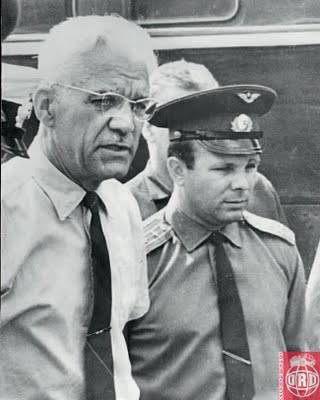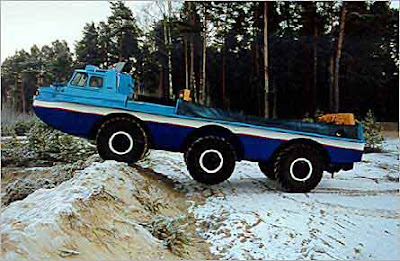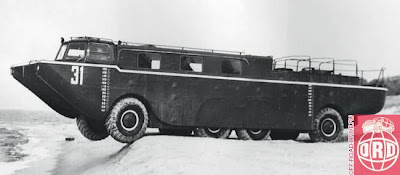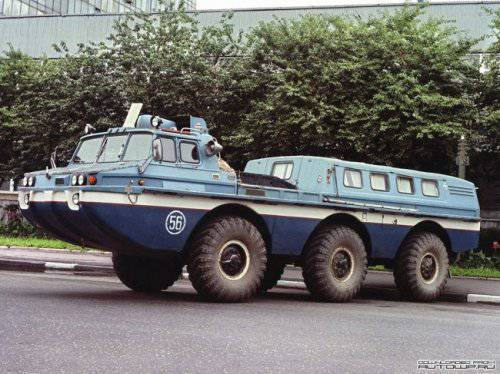Secrets of forgotten victories. Beyond the constructor
 Ultramarine color birds
Ultramarine color birdsLooking at the footage demonstrating the return from the flights of Soviet cosmonauts, many more than once paid attention to the unusual cars that were the first to arrive at the landing site. For the characteristic body color in the people they were dubbed the "blue birds"
Curious story making these machines. In July, 1951, Vitaly Andreevich Grachev was appointed deputy to the Stalin Plant, who had previously worked as the chief designer of the automobile plant in Dnepropetrovsk and started his activity at GAZ back in the 30s. He was a designer from God, a well-deserved and famous person among specialists, a laureate of two Stalin prizes.
From the very beginning, Grachev was entrusted with the development of the production of ZIS-485 amphibians. A special workshop was built for this, and the first four samples of the novelty left its doors at the end of July 1952. Soon, having passed a cycle of various tests, the car began to arrive in troops. Among other design features of this model was the system of centralized pressure change in tires, first implemented in our country. At that time, neither Grachev himself, nor his colleagues, who worked on this system, knew that they were at the beginning of a long and difficult, but interesting way, that they would have to create SUVs that would not be equal in the whole world.
His Majesty the Case
It is quite possible that the new system would have remained one of the elements of military equipment if His Majesty Chance had not intervened. In the autumn of 1952, a group of ZIS workers was sent to Zaraysk "for potatoes." Two ZIS-151 trucks and the ZIS485 amphibious vehicle were allocated for its transportation. And the latter was taken in case of cold weather, so as not to freeze the harvest, because its body had a heating system from the engine. The autumn was not warm, in November it was snowing, which covered the fields plentifully. A young engineer Vladimir Lavrentiev noticed that the amphibian overcomes drifts easier than trucks, and made conclusions.
After analyzing this unexpected discovery, the designers came to the conclusion that the system of central pressure change in tires was “to blame”. Numerous experiments began during which it was confirmed that the presence of “swapping” (as the developers called this system among themselves) significantly improves the patency of wheeled vehicles, not only in snow, but also on different types of soil. It was then that Grachev spoke out for its widespread introduction. However, not everyone agreed with this. Many military and civilian specialists, including the chief designer of the NAMI A.A. Lipgart, were against such innovations, giving no less compelling arguments from their point of view.
Not finding support from colleagues, Grachev wrote a letter to Deputy Minister of Defense G.K. Zhukov. Marshal carefully examined the proposal and appointed a comparative test, which took place in the summer of 1954. This is where the advantages of the swap show up in full. The trucks and armored personnel carriers equipped with it easily overcame swampy areas of the terrain, while their competitors almost immediately got bogged down. According to the results of the test, Zhukov proposed to produce an 25 BTR with tire inflation system for autumn maneuvers in Belarus. Zisovskoe authorities began to object, saying that this was impossible. But the deputy minister threatened to remove the entire military order from the factory, and it worked. By the autumn of the same year, the 20 BIS ZIS-152B were ready. So the innovation got a start in life.
Very little time passed, and when in July 1954, on the initiative of Zhukov, a special design office for the design of all-terrain military equipment was formed at the VMS, Vitaly Andreevich was appointed its head.
Initially, SKB had only two dozen employees who were given an extraordinarily difficult task: in the shortest possible time to design and build an average multi-purpose four-axle ultra-high-performance automobile with a lifting capacity of 5 – 6 t, which later received the ATK-6 index.
There was simply no experience in creating such a technique in our country at that time, so experiments began with prototypes that were made as needed. In 1955, the first of them appeared, based on the ZIS-151 car. He had a wheel formula 8х8 with steered wheels of the first two axles, a bonnet layout and was equipped with an in-line 6-cylinder overhead valve ZIS-120ВК engine with a power 130 hp. Along with this, the design used hydromechanical transmission, individual suspension of all axles, power steering and large-diameter tires with pumping. All this has significantly increased the throughput of the car.
Continued research
Following the first layout, a second one appeared, on which new design solutions were also being worked out - such as a stiff suspension of all wheels. But the main difference was in the displacement housing, which made it possible for this sample to overcome water obstacles. The following tests gave valuable material for further work, which was completed in 1957 with the creation of a tractor ZIL-134. The car had a 12-cylinder carburetor engine, whose power reached the 240 hp, 3-speed automatic transmission with automatic control, self-locking cross-axle differentials and a number of other innovative solutions for its time. In the final tests, the tractor freely towed the 9-ton biaxial artillery system, and its speed on bad roads was twice as high as that of the ZIS-157. In some cases, the patency was not inferior to the tracked vehicle in patency, and even exceeded them in its ability to overcome engineering obstacles.
It would seem that everything is fine, the car can be put on production, but due to financial and technological problems, the release of the 12-cylinder engine, which the novelty should have been equipped with, was not adjusted then. There was no capacity for the manufacture of a number of new units. As a result, the series did not go to the series, but instead the military adopted the heavier MAZ537. However, the accumulated experience did not disappear, the work on increasing the patency of wheeled vehicles continued, and in subsequent years, a lot of new cars appeared in the SKB ZIL. Gradually, the enterprise developed a scientific and industrial base, and at the same time a unique Soviet school of off-road wheeled vehicles was born.
And since 1958, the system of centralized tire pressure regulation has been widely used in off-road vehicles.
 From PES to "blue bird"
From PES to "blue bird"Time flows and sets new tasks for people. Not an exception was the area in which Grachev and his colleagues worked. By the middle of the 60-s, when the Soviet space program entered a new qualitative state, vehicles were needed for the rapid detection and delivery of landed descent vehicles and cosmonauts to the base. Initially, airplanes and helicopters were used for this, but at night, in bad weather, and when landing in an unplanned area, these funds were often insufficient, requiring ground support.
It was then at the initiative of S.P. The Queen of the leadership of the Air Force, in whose subordination was the search and rescue service, turned to "MosavtoZIL" with the task to create "a search and rescue vehicle with absolute maneuverability." Tactical requirements for a search and evacuation unit (PES) were approved by the Deputy Commander-in-Chief of the Air Force at the end of 1964, and in early March of 1965, Grachev was assigned to develop it.
It was necessary to create as much as a machine that could be delivered to the place of work by the Mi-6 helicopter or the AN-12 aircraft, which imposed severe restrictions on its dimensions and weight characteristics. In this case, the car would have a high cross and freely moved on the water. His capabilities should have been enough for loading and transporting the descent vehicle. But that's not all. In the cockpit it was required to arrange a crew of three and find a place to accommodate the lying astronaut. It goes without saying that the most modern means of communication for that time were present on board, as well as the necessary technical and medical equipment.
The work should be done as soon as possible, because the more often manned space flights were carried out, so, alas, it became more and more contingent upon landing. One of them occurred 19 March 1965 of the year. The descent vehicle of the Voskhod-2 spacecraft landed not in the steppe, as it was expected, but in the taiga near Perm, and cosmonauts Pavel Belyaev and Alexei Leonov had to live in the forest for two days before they could be found and removed from the landing site.
The first sample of the vehicle (PES-1) appeared before a special commission in the summer of 1966. The machine was created under the direction of V.A. Grachev, V. B. Lavrentiev, G.I. Khovansky, S.A. Kuznetsov and other workers SKB. The novelty not only met the requirements of the received technical specifications, but exceeded them in a number of indicators.
The car had an aluminum frame, serial engine ZIL-375 with maximum power 180 hp, hydromechanical transmission and independent torsion bar suspension of the outer wheels. The transfer box distributed torque equally between the left and right sides, the drive of the onboard gearboxes was carried out with cardan shafts separately for each side. High ground clearance and a small turning radius - just 9,8 m on the outer wheel - provided the qualities necessary for working in conditions of heavy off-road conditions. In addition, PES-1 easily overcame ditches wider than 2 m. The car body was made of fiberglass, its dimensions and shape ensured a good longitudinal and lateral stability when driving through water under load. In general, this was exactly what the "space bosses" wanted.
 Not thanks, but in spite of
Not thanks, but in spite ofIn the same year, a request was sent to ZIL: will the enterprise be able to manufacture 30 PES for the space agency? But plant manager P.D. Borodin then refused to manufacture cars. In vain Grachev convinced his immediate supervisor that Borodin could do this for the plant, Borodin insisted on his own. The reason, as they say, was not economic or technical difficulties, but the uneasy relationship between the director of ZIL and the head of the CSC. Formally, Grachev was subordinate to the director, but he had not only tremendous experience and authority among his colleagues, but also extensive friendly and business contacts in the leadership of the country's automobile industry, in the army and even in the government, and often used them to ensure the fulfillment of tasks assigned to the CSC. For example, it cost him nothing to agree with the aviators on carrying out the necessary experiments and placing an order for the manufacture of components for their cars not at the automobile, but at the aviation enterprise. Or ask the metallurgists to create the necessary alloy for the work with special properties.
Borodin did not like this state of affairs, and it can be understood: the notorious plan was demanded from the factory, and the special design bureau was “hanging around the neck of the enterprise”, not bringing short-term profits. And then there's Grachev with his "head-jumping" ... In general, the unique technique sometimes appeared contrary to the leadership of ZIL.
Nevertheless, despite the unfortunate mutual misunderstanding, the work continued. In the 1970, the passenger version of the rescue amphibious vehicle ZIL-5901 with the wheel formula 6х6 with a load capacity of 3200 kg was created. The machine is 11,2 long with a full weight of 16 710 kg and was designed to carry several astronauts. The maximum speed on the highway was 65 km / h, and on the water - 8 km / h. In 1975, another, even more perfect, instance appeared - ZIL-49061, in the cabin of which up to seven people could be accommodated.
 It is said that the third component of the rescue complex, the rotor-driven snow and swamp-going vehicle, was born by chance. Once a descent vehicle with astronauts landed on the surface of a frozen lake, broke through thin ice and got stuck in it, and the exit hatch was under water. All attempts to get to the module on ice did not succeed - he was very thin. The amphibian could not be used because it could not move because of the ice. Meanwhile, the air supply of astronauts was limited, with an unfavorable scenario, they could die. And although the emergency situation at that time was resolved safely, it was decided to create a vehicle capable of working even in such conditions. Soon, several versions of the "auger" appeared.
It is said that the third component of the rescue complex, the rotor-driven snow and swamp-going vehicle, was born by chance. Once a descent vehicle with astronauts landed on the surface of a frozen lake, broke through thin ice and got stuck in it, and the exit hatch was under water. All attempts to get to the module on ice did not succeed - he was very thin. The amphibian could not be used because it could not move because of the ice. Meanwhile, the air supply of astronauts was limited, with an unfavorable scenario, they could die. And although the emergency situation at that time was resolved safely, it was decided to create a vehicle capable of working even in such conditions. Soon, several versions of the "auger" appeared.So there was a technical complex consisting of three cars. Two floating cars: cargo and passenger. In the back of the truck there was a “shnekohod”, in the passenger compartment - everything needed to transport people and provide them with medical assistance in case of need. When the possibilities of amphibians were exhausted, the "auger" entered into the business. This allowed the search and rescue service in the shortest possible time to perform its task in virtually any road and weather conditions.
But the "blue birds" were not the only all-terrain vehicles born in the walls of the special design bureau. There have been developed tractors for ZIL-135 missiles and a number of other military equipment. Much of what was done in the “Grachevsky” special design bureau was innovative. For the first time in the domestic automotive industry, a system of centralized pressure control in tires was developed and introduced; for the first time in the USSR, large-sized fiberglass body parts were introduced; for the first time, new schemes for torque distribution, wheel rotation and suspension were used.
And how many unique developments have remained unfulfilled and classified! Moreover, many of them, according to experts, could well be in demand even today. Could, but, most likely, this will not happen. Indeed, after the death of V.A. Grachev in 1978 year to continue his business turned out to be practically no one. It so happened that he didn’t have time to prepare his peer in terms of successor level or didn’t want ... Now one can only guess about the reasons.
With the beginning of perestroika, the collapse of the USSR and the economic cataclysms which followed after them, SKB ZIL ceased to exist. For a while, Vitaliy Andrevich’s supporters tried to keep the design school he created, but this didn’t work out well, and now it’s obvious that with the departure of the last of Grachev’s former colleagues, the school he founded seems to die. It's a pity!
By water as by land
One of the “ancestors” of the “blue birds” was the experimental ZIS-135 P - a floating car with a plastic case of length 13,8 m, built in the year 1965. Wheel formula - 8x8. Load capacity - 6 t. Gross weight - 20 t. The machine was equipped with two motors ZIL-375 with power 180 hp. each. Maximum speed on the highway - 65 km / h, on the water - 16,5 km / h. The machine could be used in agitation up to 5 points and swim among the ice floes. It was tested as a large transport vehicle in the Baltic and North Sea, while receiving high marks from military specialists. Polar explorers were also interested in it, however, despite the general approval, for several reasons this car never went into the series.
Secrets of forgotten victories. Beyond the constructor
Secrets of forgotten victories -Great unknowns --Limiting Designer Recalling the great men of the century, 10 identified the best automotive designers of the 20 century. These include Cadillac founder Henry Lilland, unsurpassed Henry Ford, the world famous Ferdinand Porsche, but our Russian designer Vitaly Grachev is on the list. The founder of a unique design office for the creation of all-terrain vehicles. During his war, both soldiers and marshals fought on his vehicles. His BA-64 armored car became the best in its class, reached Berlin, and rightfully took part in the Victory Parade. In 1954, at the ZIL plant, he created a special design bureau. His ATVs overcame snow, sand, mud, beat all world records, it is not surprising that some of them were hunted by foreign intelligence. Rocket carriers Grachev stood in the service for decades. Until now, his search complex 'Blue Bird' rescues our astronauts after their landing on Earth. Unfortunately, this is the only currently working machine from 88, designed by Vitaly Andreevich Grachev.

Information